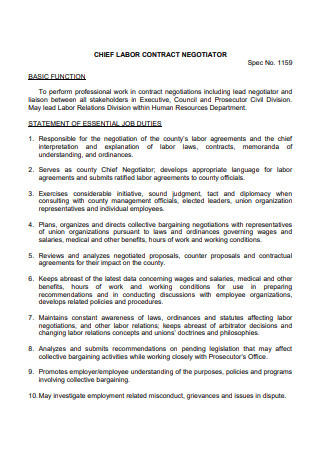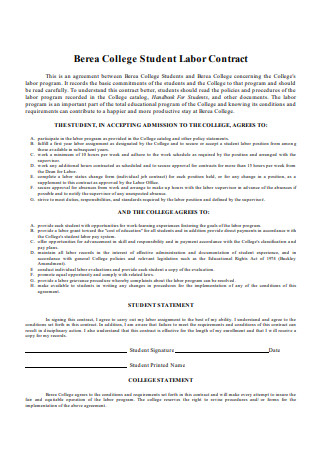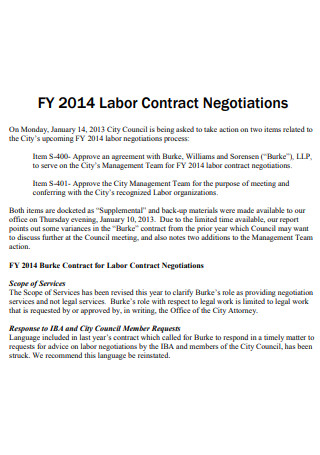11+ Sample Labor Contract
-

Labor Contract Template
download now -

Chief Labor Contract
download now -

Standard Labor Contract
download now -

College Student Labor Contract
download now -

Formal Labor Contract
download now -

Labor Services Contract
download now -

Farm Labor Contractor Bond
download now -

Construction Labor Contract
download now -

Labor Contract Calculator
download now -

Labor Contract Law
download now -

Printable Labor Contract
download now -

Labor Contract Succession Act
download now
FREE Labor Contract s to Download
11+ Sample Labor Contract
What is a Labor Contract?
What Is Typically Included in a Labor Contract?
What is the Division of Labor?
What are the Types of Employment Contracts?
What are the Advantages and Disadvantages of Contract Labor/Employment?
What are the Sectors of the Labor Industry?
How to Prepare an Effective Labor Contract
FAQs
What are the four different types of labor?
What is the difference between a job offer and an employment contract?
How does contract employment work?
As standards and practices regarding labor have evolved through the years, getting an agreement done and a work contract finalized remains essential, to ensure that all the terms are clearly stated and met, as well as the interests of the parties involved are protected.
What is a Labor Contract?
By definition, a labor contract is a legal and important document that establishes the rules and regulations that will oversee the working relationship between the employer and the employee. The contract includes the rights and responsibilities of the parties involved, as well as the things to do if one of the parties fails to fulfill the responsibilities that are stated in the agreed contract. A labor contract also states the specific commitments that the employer is making with the employee. This typically includes a commitment to maintaining an environment that is compliant with safety rules and regulations. A labor contract also refers to any kind of collective bargaining agreement with any labor union, works council, or labor organization.
What Is Typically Included in a Labor Contract?
The contents of a labor contract greatly vary by businesses and companies and the types of labor they offer, but generally speaking, they must consist of the following terms:
What is the Division of Labor?
The term Division of Labor refers to the segmentation of the tasks, with each individual focusing on a specific part of the production process. Its value in economics lies in the fact that a given number of workers can produce a greater amount of output when this method is implemented compared to the workers that don’t use this method. The increase in production rates is usually attributed to increased learning dexterity and savings in wasted motion during the transition from one type of work to the next one.
What are the Types of Employment Contracts?
The types of employment contracts greatly vary from each employer and where they are located. Here are the most common types:
What are the Advantages and Disadvantages of Contract Labor/Employment?
Contract employment comes with the following advantages and disadvantages:
Advantages
- This serves as a chance to impress the employer, which can lead to a permanent full-time offer.
- You are eligible to deduct a portion of your work-related expenses that you won’t normally qualify for.
- You can take on different contracts with different employers, thus giving you the chance to prove yourself to a number of different employers.
- You can find yourself having less involvement in workplace politics which can heavily influence your mentality, and instead, you focus more on doing your job properly.
- For employers, a big advantage in getting someone to work on a contractual basis is the ease of separation.
- Industrial relations problems are minimized since those who are working under a labor contract are not considered as a bargaining unit.
Disadvantages
- Being only on a contractual basis, employees may not invite you to their “inner tier” and may limit the amount of information that they share with you.
- The employer will not deduct your pay for taxes, since you are only there on a contractual basis. You must do this on your own.
- No benefits may be given to you from the employer such as employee leave, compared to those working on a permanent basis.
- You cannot receive severance pay at the end of your term from the employer
- When you decide to combine two contract-based jobs at a single time, you can find that managing your own time is at a premium.
- Contract employees are usually devoid of protection under a place’s labor laws.
What are the Sectors of the Labor Industry?
There are many ways to categorize the different kinds of labor work. In economic terms, it can be divided into the following three terms, known as the three-sector model:
How to Prepare an Effective Labor Contract
Preparing an effective Labor Contract necessitates the following steps that should be followed:
1. Writing the title
The labor contract needs a title for both parties to be able to know and understand what kind of labor contract it is going to be, whether it is a part-time contract or a full-time contract. It is also important that the title is written legibly and is located in a place where it can be seen clearly.
2. Writing the basic information.
The next step that can be taken in writing a labor contract is including the basic information from the parties involved. It includes the names, the date of the agreement, the start and end date of the project, the location of the project, and the name and the kind of project that the employee will have to work on.
3. Mention the position-related responsibilities.
In this step, the employer should state the responsibilities of the employee that is also related to the type of work that he/she will undergo. This is important to make sure that the worker knows what is expected of them. This includes the role, the title, and the corresponding duties that the worker has to complete throughout the duration of the labor contract. It is important that everything in this step should be written very clearly without room for misinterpretation.
4. Write the financial details.
In this section, details regarding how the worker should be financially compensated are written. This must be also written clearly in order to avoid unnecessary confusion between the employer and the worker. The details regarding the financial compensation should include the amount of compensation, the method of payment whether it is hand-in or bank deposit, the periods in when the worker will be paid, and any other performance-related bonuses.
5. Include details on how disputes and claims are handled.
Many things can happen to the worker while working on the project and some of them may put the worker in a disadvantageous state. For this reason, a labor contract should also include the various ways the employer should properly handle any disputes and claims that they may encounter from the worker. This is also the part of the labor contract that should not be written vaguely and should be done with little to no room for interpretation.
6. Include a signature area and consult with a lawyer.
This area is provided so that the employer and the worker have spaces to sign should they have no further clarifications and the worker is satisfied with the terms to the point that he/she will not renegotiate or contest a part of the contract. Once this is done and the contract is written, it is also essential to have a lawyer or someone with legal and proper authority to review the labor contract that is made. Consulting to a lawyer helps businesses from future litigation and troubles and ensures the protection of both the employer and the worker.
FAQs
What are the four different types of labor?
There are four different types of labor and are sorted by skill. Here they are:
- Unskilled Labor – generally consists of those workers who work primarily with their hands. Workers in unskilled labor have the lowest amount of capital invested towards them and usually receive the lowest wages.
- Semi-skilled Labor – Workers in this type of labor have enough mechanical abilities to operate machinery or equipment, such as floor polishers and dishwashers. They also have higher wages compared to workers in unskilled labor.
- Skilled Labor – workers in this category can operate more complex equipment, and can perform tasks with minimal supervision. They also receive a higher human capital, resulting in higher wages.
- Professional Labor – consists of workers who have the highest level of knowledge-based education and management skills. They are the highest wage earners in this category.
What is the difference between a job offer and an employment contract?
A job offer letter is an unofficial way of presenting candidates with the most basic terms of employment. This is not legally binding. An employment contract includes more detailed terms and conditions that are not included in the job offer and is a legally-binding document. The terms must be agreed upon by both the employee and employer for the contract to be set in motion.
How does contract employment work?
Contract employments are not permanent full-time jobs and employees who work under contract employment do not share the same benefits and compensations compared to those who are permanent workers. Employers of contract workers usually not share the same amount of information to them as they would do to permanent workers.
In making a labor contract, it is important that no vague terms or prohibited clauses are included, such as forbidding the worker the opportunity to join an established labor union in his/her first few days or weeks as an employee. Fortunately, this practice is prohibited anymore. But any potential employee should still watch out for any discrepancies written here. In this article, examples of a proper labor contract are posted for you to download and for your personal use or reference.
